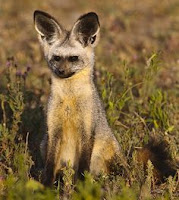 |
| Spekes hinged tortoise. |
Within Africa
a large diversity of tortoises are found; from the African spurred tortoise who
is the third largest tortoise in the world, to the rather speedy (for a
tortoise) and decent climbing, leopard tortoise, among many more.
In Southern
Africa, the family of hinged tortoises are divided into four subspecies, all of
which belong to the genus known as Kinixys. The use of the word ‘hinged’ is a
result of their ability to close the hinged rear part of their carapace (back
part of shell).
The spekes
hinged tortoise is medium sized, with a patterned shell made up of light and
dark patches or rings, and their colours range from light yellowish through to
shades of brown. Their shells have their own set of nerve endings, allowing
them to feel every rub, touch or scratch.
 |
| The hinge. |
Their hinges
develop at about 2 years old, appearing towards the back of their shells and
above their hind legs. Used for protective measures; when closed downwards it
protects their back legs and tails.
Habitat
They are
found living in savannahs and rocky areas with dry bushes, in central and Eastern
Africa, from Zimbabwe to the North Western and Northern provinces of South
Africa, and along the coastal plains of Mozambique through to Swaziland.
Behaviour
Tortoises
prefer to live their existences alone, only meeting up to mate, and do not bond
or form groups. A happy tortoise is an active tortoise; unhappy or stressed
tortoises tend to not make much movement.
They pick up
scents using their vomeronasal organ, located on the roof of their mouths, by
pumping their throats to circulate air through their nose and mouth.
When needing
to withdraw in their protective shell they have to empty their lungs first, so
when startled they are often heard exhaling loudly and quickly.
Diet
Spekes hinged tortoises are mostly
active during rain and in the evening time, which is somewhat unique amongst
tortoises.
These tortoises are omnivores and eat a
varied diet of leaves, small flowers, grass, succulents, fungi, fruit,
mushrooms, snails, beetles and millipedes.
Reproduction
The mating
game between tortoises involves the male nudging, pushing or moving the female
and if she doesn’t walk away, mating will follow. Males are the noisier of the
two, making groaning hisses during a mating session.
A female will
open up her hinged and well-developed posterior in order to lay her eggs. She
will lay a small clutch of between 2 to 6 eggs, usually after the rain from
late afternoon into the night.
 |
| Spekes hinged tortoise. |
Did you
know?
Spekes hinged tortoises are named after
the British explorer who discovered the source of the Nile River, Captain John
Hanning Speke.
Their predators include the secretary
bird and monitor lizards.
A group of tortoises are called a creep.

























